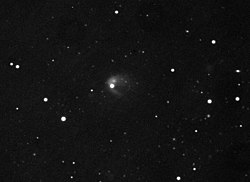
Back حزام المذنبات الرئيسي Arabic Камета галоўнага пояса Byelorussian Hauptgürtelkometen German Päävyöhykkeen komeetta Finnish Comète de la ceinture principale French אסטרואיד פעיל HE Հիմնական գոտու գիսաստղեր Armenian Famiglia delle comete della fascia principale Italian メインベルト彗星 Japanese 소행성대 혜성 Korean


Active asteroids are small Solar System bodies that have asteroid-like orbits but show comet-like visual characteristics.[1] That is, they show a coma, tail, or other visual evidence of mass-loss (like a comet), but their orbits remain within Jupiter's orbit (like an asteroid).[2][3] These bodies were originally designated main-belt comets (MBCs) in 2006 by astronomers David Jewitt and Henry Hsieh, but this name implies they are necessarily icy in composition like a comet and that they only exist within the main-belt, whereas the growing population of active asteroids shows that this is not always the case.[2][4][5]
The first active asteroid discovered is 7968 Elst–Pizarro. It was discovered (as an asteroid) in 1979 but then was found to have a tail by Eric Elst and Guido Pizarro in 1996 and given the cometary designation 133P/Elst-Pizarro.[2][6]
- ^ Andrews, Robin George (18 November 2022). "The Mysterious Comets That Hide in the Asteroid Belt - Comets normally fly in from the far reaches of space. Yet astronomers have found them seemingly misplaced in the asteroid belt. Why are they there?". The New York Times. Retrieved 18 November 2022.
- ^ a b c David Jewitt. "The Active Asteroids". UCLA, Department of Earth and Space Sciences. Retrieved 2020-01-26.
- ^ Cite error: The named reference
JHA15was invoked but never defined (see the help page). - ^ Chang, Kenneth; Stirone, Shannon (19 March 2019). "The Asteroid Was Shooting Rocks Into Space. 'Were We Safe in Orbit?' - NASA's Osiris-Rex and Japan's Hayabusa2 spacecraft reached the space rocks they are surveying last year, and scientists from both teams announced early findings on Tuesday (03/19/2019)". The New York Times. Retrieved 21 March 2019.
- ^ "Hubble Observes Six Tails from an Unusual Asteroid". Space Telescope Science Institute (STScI), official YouTube channel for the Hubble Space Telescope. Archived from the original on 2021-12-22. Retrieved 2014-11-15.
- ^ Hsieh, Henry (January 20, 2004). "133P/Elst-Pizarro". UH Institute for Astronomy. Archived from the original on 26 October 2011. Retrieved 22 June 2012.
© MMXXIII Rich X Search. We shall prevail. All rights reserved. Rich X Search